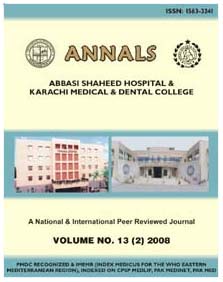
| |
| Home |
| Editorial Staff |
| Instruction to Authors |
| Journal-Issues |
| Policy |
| Copyright |
| MEGALOBLASTIC ANEMIA, SEEN IN 48 CASES OF PANCYTOPENIA
GULNAZ KHALID, MOHAMMAD AYUB MOOSANI, LAEEQ AHMED, ABSTRACT Objective: To assess megaloblastic anaemia in patients presenting with pancytopenia. Study Design: Descriptive study. Patients and Methods: Hospitalized patients referred for bone marrow examination for the work up of pancytopenia were selected. Complete blood count was done on haematology auto analyzer. Bone marrow aspiration was done for cytology. Perl`s iron staining was done in patients showing low blood indices. Result: Forty eight (48) patients underwent bone marrow aspiration for cytology for the work up of pancytopenia. Nineteen (19) patients (39 %) showed megaloblastic anaemia. Macrocytosis and hypersegmented neutrophils were the most common finding on peripheral blood smear. Fregmented red cells were seen in 13 patients showing classical finding of megaloblastic anaemia. Conclusion: Megaloblastic anaemia was found to be the most common cause of pancytopenia. Diagnosis of megaloblastic anaemia requires only complete blood count, peripheral blood smear and bone marrow cytology, which is cost effective. Nutritional factors and recurrent infection seem to be associated strongly with megaloblastic anemia.
|
For Full text contact to:
|
|
Assistant Professor Pathology KMDC and Abbasi Shaheed Hospital, Karachi *
|

Copyright © 2009 Abbbas Shaheed Hospital and Karachi Medical & Dental College.
All rights reserved.
Designed & Developed by: Creative Designers